Maintaining a clean and inviting pool requires consistent cleaning efforts. While skimming and netting debris from the surface are essential, regular vacuuming is crucial for removing dirt, settled particles, and debris from the bottom of your pool.
An important component for pool vacuuming is the hose. The right hose ensures a smooth and efficient cleaning experience.
What Are the Different Types of Swimming Pool Vacuum Hoses?
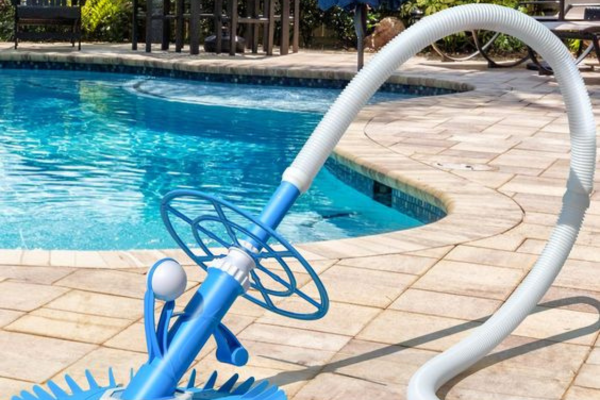
Swimming pool vacuum hoses are essential tools for effective pool maintenance, designed to meet a range of specific cleaning requirements. Here are the main types of swimming pool vacuum hoses:
Standard Swimming Pool Vacuum Hoses
Material: Constructed from UV-inhibited materials to resist degradation from sunlight and pool chemicals.
Features: These hoses are lightweight, flexible, and equipped with molded cuffs for straightforward attachment to vacuum heads and skimmers.
Applications: Ideal for routine pool cleaning tasks, available in multiple lengths and diameters.
Cost: For example, a standard hose with a 1.5-inch diameter and 40-foot length is priced at $78.48.
Heavy-Duty Spiral Wound Swimming Pool Vacuum Hoses
Construction: Built to be kink-free and collapse-resistant, enhancing durability and ease of use.
Suitability: Appropriate for both in-ground and above-ground pools, these hoses withstand more demanding cleaning tasks.
Pricing: A 35-foot heavy-duty spiral wound hose with a 1.5-inch diameter costs $49.98.
Telescopic Pole Vacuum Hoses.
Integration: These hoses connect to telescopic poles, allowing for adjustable length to enhance reach across the pool.
System: Commonly used in manual pool vacuum systems where the head attaches to a telescopic pole for better maneuverability.
Compatibility: Fits various vacuum heads and cleaning attachments, with poles that can extend up to 16 feet.
Flexible Standard Manual Pool Vacuum Hoses.
Design: Specifically made for manual vacuums, these hoses are lightweight and highly flexible.
Usability: best suited for above-ground pools, easy to manage and store.
Example: A 36-foot hose with a 1.25-inch diameter is available for $54.99.
Cordless Pool Vacuum Hoses
Features: These hoses are part of handheld or battery-operated vacuums, eliminating the need for a connection to the pool’s filtration system.
Advantages: Offers the convenience of cordless operation, perfect for quick clean-ups and spot cleaning.
Example: The Enhulk cordless pool vacuum includes a telescopic pole and delivers powerful suction for effective debris removal.
How to Choose the Right Swimming Pool Vacuum Hose?

Choosing the right swimming pool vacuum hose is crucial for effective pool maintenance. Here’s a guide to help you select the most suitable hose based on key factors:
Selecting the correct diameter
Options: The common diameters for pool vacuum hoses are 1.5 inches and 1.25 inches.
Considerations: A 1.5-inch-diameter hose typically offers better suction and is suitable for larger pools or heavier debris. A 1.25-inch hose may be sufficient for smaller pools with lighter cleaning needs.
Determining the Appropriate Hose Length
Evaluation: Measure the farthest distance from your pool’s skimmer or vacuum port to the opposite end of the pool. Add a few extra feet to ensure the hose reaches comfortably without stretching.
Advice: Opt for a longer hose than you think you might need to avoid unnecessary strain on the vacuum equipment and to ensure ease of movement around the pool.
Advantages of Kink-Free Swivel Cuff Design.
Functionality: Kink-free swivel cuffs prevent the hose from twisting and tangling, which can obstruct water flow and reduce suction efficiency.
Benefit: This design enhances maneuverability and durability, ensuring consistent performance and extending the lifespan of the hose.
When selecting a pool vacuum hose, it is essential to consider these factors to ensure optimal compatibility with your pool size and cleaning requirements. A well-chosen hose enhances cleaning efficiency and contributes to the overall maintenance of a clean and healthy pool.
What Are the Key Features of a High-Quality Pool Vacuum Hose?
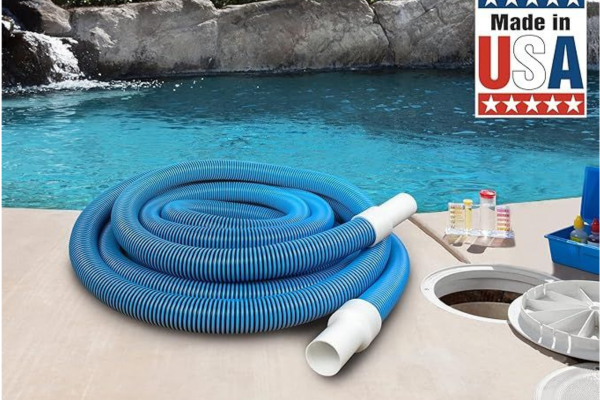
A high-quality pool vacuum hose should possess several key features to ensure durability, versatility, and effective cleaning performance. Here are the essential attributes to look for:
Heavy-Duty Construction Materials
Description: Opt for hoses made from heavy-duty materials that are UV-resistant and capable of withstanding exposure to pool chemicals and weather elements.
Importance: These materials prevent the hose from degrading, cracking, or splitting, thus prolonging its useful life.
Incorporating a backwash hose
Utility: Some pool vacuum hoses come with an integrated backwash hose, which is used to reverse the flow of water and clean out filters.
Advantage: This feature is particularly beneficial for maintaining the pool’s filtration system and ensuring optimal water clarity.
Compatibility with Different Vacuum Heads.
Flexibility: Ensure the hose is compatible with a variety of vacuum heads. This compatibility allows for the use of the hose with different types of pool cleaning systems.
Benefit: Compatibility with multiple vacuum heads adds to the hose’s versatility, making it a more cost-effective and practical investment for pool maintenance.
Selecting a pool vacuum hose with these features will significantly enhance your pool cleaning routine, offering a robust, versatile, and long-lasting solution to pool maintenance challenges.
How to Properly Maintain and Store a Swimming Pool Vacuum Hose?
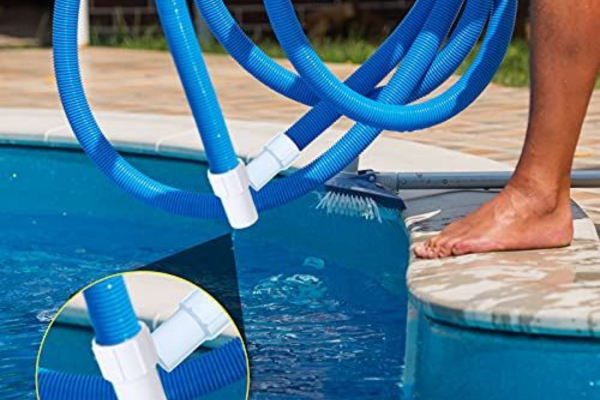
Maintaining and storing a swimming pool vacuum hose correctly is essential to extending its lifespan and ensuring its effectiveness. Here are guidelines on how to properly care for your pool vacuum hose:
Proper Cleaning and Drying After Use
Procedure: Rinse the hose thoroughly with fresh water to remove chlorine and other chemicals.
Purpose: This prevents chemical degradation and buildup inside the hose, which can impede water flow and suction.
Use correct storage to prevent damage
Method: Coil the hose loosely in large loops and store it flat, or hang it in a cool, dry place away from direct sunlight.
Reason: Proper storage prevents the formation of kinks and cracks, protecting the structural integrity of the hose.
Regular Checks for Leaks and Wear
Inspection: Periodically examine the hose for any signs of wear, leaks, or damage.
Importance: Early detection of issues allows for timely repairs or replacements, thus avoiding potential failures during pool cleaning sessions.
By adhering to these maintenance and storage practices, you can significantly enhance the durability and functionality of your swimming pool vacuum hose, ensuring it remains a reliable part of your pool maintenance kit.
Why Opt for a Spiral Wound Swimming Pool Vacuum Hose?

Opting for a spiral-wound swimming pool vacuum hose offers several advantages, particularly in terms of construction, durability, and versatility.
Benefits of Spiral Wound Construction
Feature: The spiral wound design consists of continuous spiral ribbing that reinforces the hose.
Advantage: This construction enhances the hose’s resistance to crushing and kinking, ensuring uninterrupted suction and flow.
Enhanced Durability and Flexibility
Durability: Spiral wound hoses are made from materials that can withstand frequent use and exposure to pool chemicals and UV radiation.
Flexibility: Despite their strength, these hoses remain flexible, which is crucial for easy maneuverability and efficient pool cleaning.
Use in both in-ground and above-ground pools
Versatility: The robust nature of spiral wound hoses makes them suitable for various pool types, whether in-ground or above-ground.
Performance: Their design allows for effective cleaning across different pool shapes and sizes, maintaining high performance in diverse conditions.
Choosing a spiral wound hose for your pool vacuum system thus ensures a reliable, long-lasting tool that provides superior performance in maintaining pool cleanliness.
What Are the Common Issues Faced with Pool Vacuum Hoses?
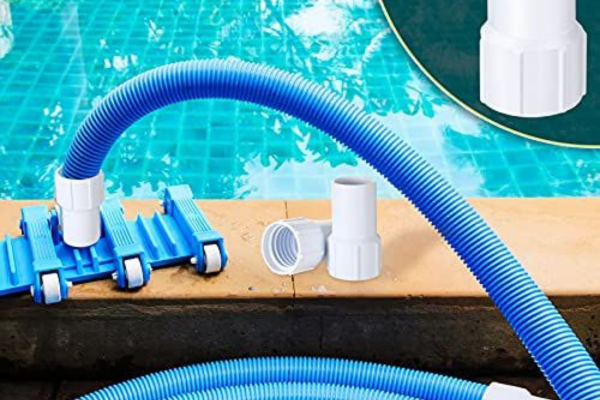
Pool vacuum hoses are essential for maintaining clean swimming environments, but they can encounter several common issues that affect their functionality:
Kinks and Tangles Affecting Suction.
Problem: The hose may develop kinks and tangles during use or storage, which impede water flow and reduce suction efficiency.
Impact: This can lead to inadequate cleaning and increased strain on the pool’s pump and filtration system.
Leaks Due to Wear and Tear.
Cause: Over time, the material of the hose can degrade due to exposure to chemicals and UV light or suffer physical damage, leading to leaks.
Consequence: Leaks diminish the vacuum’s suction power, requiring more time and energy to clean the pool effectively.
Issues with Swivel Cuff Functionality.
Function: Swivel cuffs are designed to rotate freely, preventing the hose from twisting.
Common Faults: If the swivel cuff becomes stiff or malfunctions, it can cause the hose to coil or kink, complicating the cleaning process and potentially causing damage to the hose.
Addressing these issues promptly can help maintain the efficiency of your pool cleaning routine and extend the life of the vacuum hose.
How to Connect and Use a Swimming Pool Vacuum Hose?
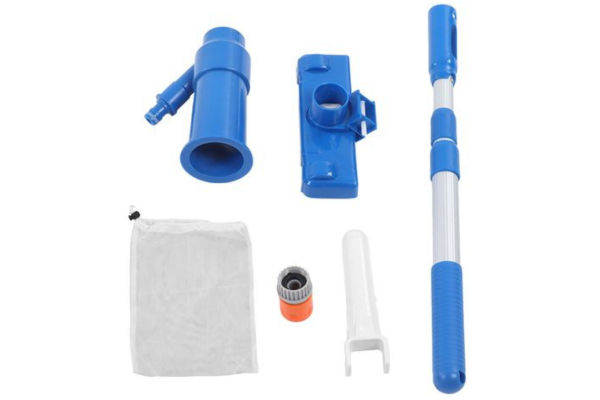
Connecting and using a swimming pool vacuum hose involves several key steps to ensure efficient cleaning and maintenance of your pool. Here is a guide to properly setting up and utilizing your pool vacuum hose:
Attaching the Hose to the Skimmer or Vacuum Head
Process: Connect one end of the vacuum hose to the vacuum head, which is already attached to the telescopic pole. Submerge the vacuum head into the pool, and fill the hose with water to remove air. Connect the other end of the hose to the skimmer or dedicated suction port.
Purpose: Ensuring the hose is filled with water and free of air is crucial for maintaining strong suction and effective pool cleaning.
Proper Techniques for Backwashing and Cleaning
Backwashing: This is a method used to clean the pool’s filtration system by reversing the flow of water. Connect the backwash hose to your filter’s backwash port, and run water through it to clear out accumulated debris.
Regular Cleaning: Regularly remove and clean the vacuum head and hose to prevent the buildup of debris and chemicals that can degrade the hose over time.
Utilizing a Telescopic Pole for Easier Reach.
Advantage: A telescopic pole allows for adjustable length, making it easier to reach all areas of the pool without straining.
Use: Attach the pole to the vacuum head for better control and to ensure thorough cleaning across the entire pool.
Following these steps will help you effectively use and maintain your swimming pool vacuum hose, enhancing your pool’s cleanliness and hygiene.

Meet David Thomas, a seasoned professional with nearly 8 years of experience specializing in inspecting and resolving issues related to swimming pools. With his expertise and meticulous attention to detail, David ensures the safety and functionality of pools, making them a refreshing oasis for all to enjoy. Whether it’s troubleshooting equipment or maintaining water quality, David’s proficiency guarantees top-notch solutions tailored to meet every pool owner’s needs.
